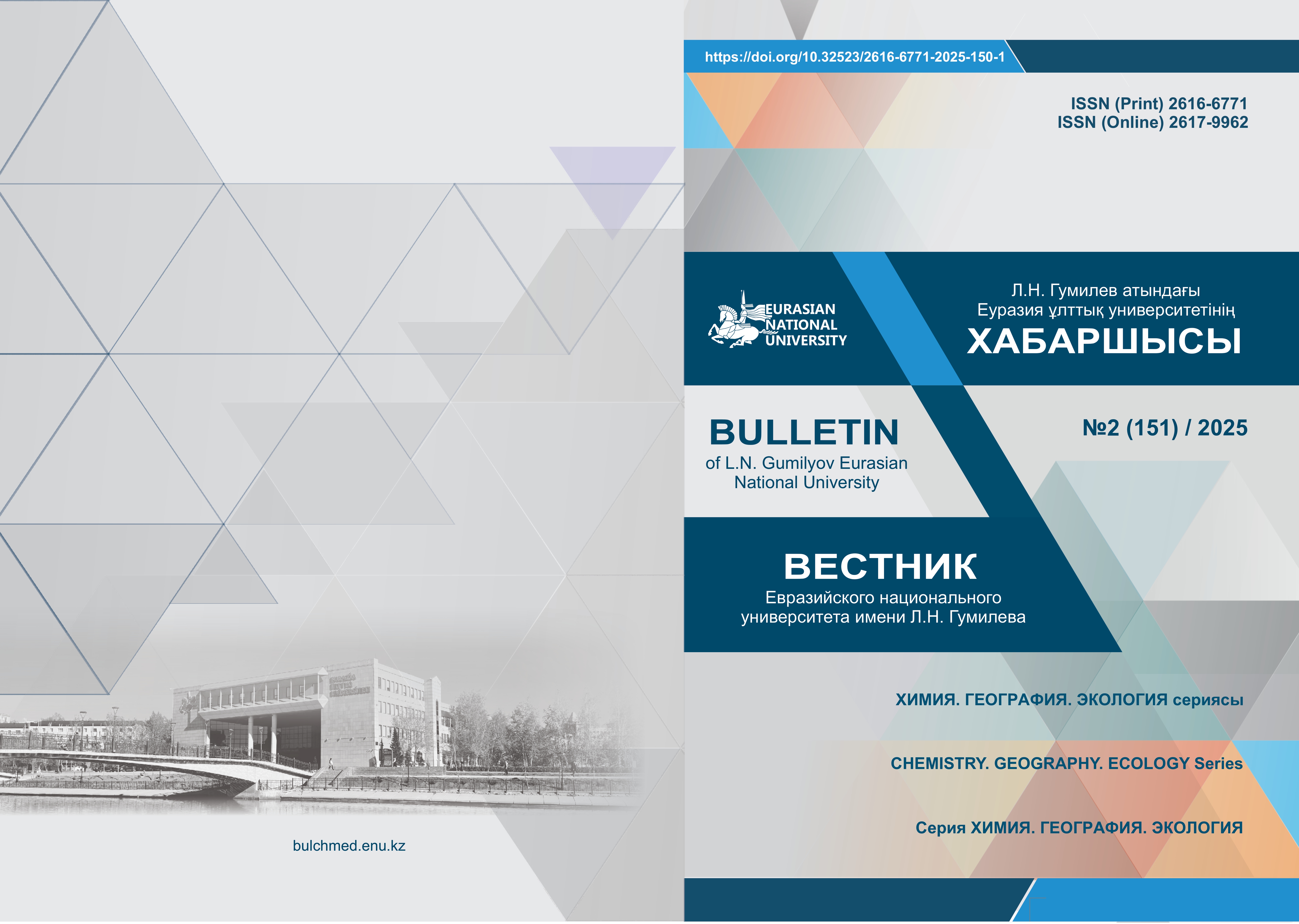Granulometric composition of Astana's soil
Views: 806 / PDF downloads: 171
DOI:
https://doi.org/10.32523/2616-6771-2025-151-2-255-269Keywords:
soil, granulometric composition, soil fertility, urbanization, anthropogenic impactAbstract
Understanding the granulometric composition of urban soil is essential for assessing pollution levels and managing soil resources effectively. The particle-size distribution of soil significantly affects the movement and accumulation of pollutants, water infiltration, chemical interactions, and biological processes, including microbial activity and nutrient cycling. This study investigated the mechanical composition of soils in Astana by collecting samples from 60 sites across various administrative districts, including Esil, Baikonur, Almaty, Saryarka, and Nura. The analysis showed that heavy loamy soils dominate throughout the city. The average clay content in the soil samples was 44.9% in Esil, 45.7% in Baikonur, 45.0% in Almaty, 42.6% in Saryarka, and 45.4% in Nura. These types of soils are beneficial for agricultural and landscaping purposes because they retain moisture and nutrients well. However, they also have limitations, such as a higher susceptibility to erosion, anthropogenic contamination, and reduced permeability under dry conditions, which may affect vegetation growth. Given these challenges, proper management strategies are needed to protect urban soils from degradation and ensure long-term functionality. The results of this research provide valuable data for environmental zoning and decision-making. They can support sustainable land use planning, pollution prevention, and long-term soil quality monitoring in Astana, contributing to the city’s ecological safety, resilience, and green infrastructure development.
Downloads
References
Arnfield, A.J. (2003). Two decades of urban climate research: A review of turbulence, exchanges of energy and water, and the urban heat island. International Journal of Climatology 23(1), 1–26. https://doi.org/10.1002/joc.859
Béchet, B., Morvan, B., Morel, J.L. (2019). Urban soils under stress: Understanding the urban environment for sustainable cities. Urban Environmental Quality 28(2), 123–135.
Brevik, E.C., & Burgess, L.C. (2014). The influence of soils on human health. In Soils and human health. CRC Press, 1-30. https://doi.org/10.1201/b16666-3
Chen, M., Xu, P., Zeng, G., Yang, C., Huang, D., Zhang, J. (2017). Heavy metal contamination and health risk assessment in urban soils of China. Ecotoxicology and Environmental Safety 142, 67–74. https://doi.org/10.1016/j.ecoenv.2017.03.034
Department of Urban Planning and Architecture. (2019). General plan for the development of Astana until 2035. Astana.
Díaz, J., Garcia, R., Lopez, A. (2018). Green spaces and human wellbeing: A review of epidemiological evidence. Environmental Research 160, 330–338. https://doi.org/10.1016/j.envres.2017.10.017
Edmondson, J.L., Davies, Z.G., McHugh, N., Gaston, K.J., Leake, J.R. (2011). Organic carbon hidden in urban ecosystems. Scientific Reports 1, 202. https://doi.org/10.1038/srep00202
Equiza, M.A., Day, M.E., Jagels, R. (2017). Physiological responses of urban trees to saline soils. Urban Forestry & Urban Greening 23, 10–18. https://doi.org/10.1016/j.ufug.2017.01.003
Goldewijk, K.K., Beusen, A., Janssen, P. (2010). Long-term dynamic modelling of global population and built-up land using the HYDE database. The Holocene 20(4), 565–573. https://doi.org/10.1177/0959683609356587
Hiemstra, T., van Riemsdijk, W.H. (2003). Adsorption and surface complexation of trace metals on goethite. Journal of Colloid and Interface Science 261(1), 255–264. https://doi.org/10.1016/S0021-9797(03)00067-6
ISO 12536-2014. (2014). Soils. Methods for determination of particle-size and microaggregate composition. Committee for Technical Regulation and Metrology of the Republic of Kazakhstan.
Kachinskiy, N.A. (1965). Mechanical composition and physical properties of soils. Vysshaya Shkola.
Lehmann, A., Stahr, K. (2007). Nature and significance of anthropogenic urban soils. Journal of Soils and Sediments 7(4), 247–260. https://doi.org/10.1065/jss2007.08.242
Li, X., Feng, L. (2018). Challenges and strategies in managing urban soil contamination. Environmental Pollution 242, 174–181. https://doi.org/10.1016/j.envpol.2018.06.060
Lorenz, K., Lal, R. (2009). Biogeochemical C and N cycles in urban soils. Environment International 35(1), 1–8. https://doi.org/10.1016/j.envint.2008.05.006
Morel, J.L., Chenu, C., Lorenz, K. (2015). Ecosystem services provided by soils of urban, industrial, traffic, mining and military areas (SUITMAs). Journal of Soils and Sediments 15(8), 1659–1666. https://doi.org/10.1007/s11368-014-0926-0
Müller, A., Repmann, F., Schulin, R. (2021). Soil sealing and its impact on urban soil functions – A review. Science of the Total Environment 753, 142140. https://doi.org/10.1016/j.scitotenv.2020.142140
Pavao-Zuckerman, M.A. (2008). The nature of urban soils and their role in ecological restoration in cities. Restoration Ecology 16(4), 642–649. https://doi.org/10.1111/j.1526-100X.2008.00482.x
Pickett, S.T.A., Cadenasso, M.L., Grove, J.M., Nilon, C.H., Pouyat, R.V., Zipperer, W.C., Costanza, R. (2001). Urban ecological systems: Linking terrestrial, ecological, physical, and socioeconomic components of metropolitan areas. Annual Review of Ecology and Systematics 32, 127–157. https://doi.org/10.1146/annurev.ecolsys.32.081501.114012
Plyaskina, O.V., Ladonin, D.V. (2009). Content and distribution of heavy metals in Moscow soils. Eurasian Soil Science 42, 693–701. https://doi.org/10.1134/S1064229309060052
Redkov, A.I. (1961). Soils of Kazakhstan. Science Publishing.
United Nations. (2018). World urbanisation prospects: The 2018 revision. UN Department of Economic and Social Affairs. https://www.un.org/development/desa/publications/2018-revision-of-world-urbanisation-prospects.html
Uspanov, V.M. (1967). Geography of soils of the Kazakh SSR. Nauka.
Zhang, C., Luo, L., Xu, W. (2020). Impacts of land use changes on soil properties in urbanizing areas. Environmental Monitoring and Assessment 192(3), 177. https://doi.org/10.1007/s10661-020-8113-6
Zhu, Y., Zhang, W. (2019). The role of soil structure in ecosystem services in urban green spaces. Urban Forestry & Urban Greening 43, 126373. https://doi.org/10.1016/j.ufug.2019.126373
Downloads
Published
Issue
Section
License
Copyright (c) 2025 Тургут Тюзюн Онай, A. Zandybai, A. Kydyrova (Author)

This work is licensed under a Creative Commons Attribution-NonCommercial 4.0 International License.








